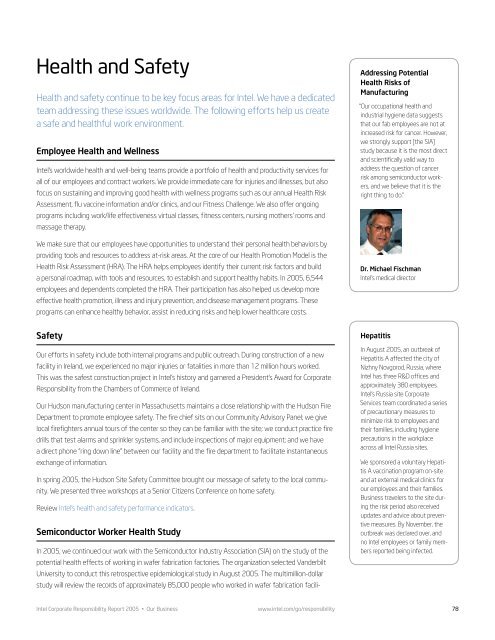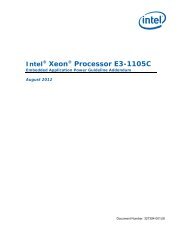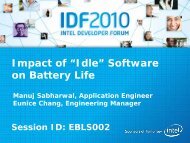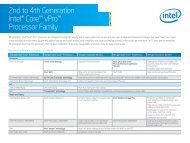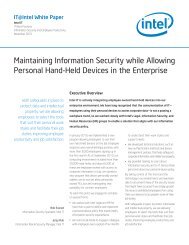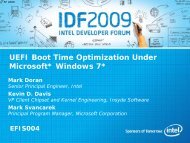Download - Intel
Download - Intel
Download - Intel
You also want an ePaper? Increase the reach of your titles
YUMPU automatically turns print PDFs into web optimized ePapers that Google loves.
Health and Safety<br />
Health and safety continue to be key focus areas for <strong>Intel</strong>. We have a dedicated<br />
team addressing these issues worldwide. The following efforts help us create<br />
a safe and healthful work environment.<br />
Employee Health and Wellness<br />
<strong>Intel</strong>’s worldwide health and well-being teams provide a portfolio of health and productivity services for<br />
all of our employees and contract workers. We provide immediate care for injuries and illnesses, but also<br />
focus on sustaining and improving good health with wellness programs such as our annual Health Risk<br />
Assessment, flu vaccine information and/or clinics, and our Fitness Challenge. We also offer ongoing<br />
programs including work/life effectiveness virtual classes, fitness centers, nursing mothers’ rooms and<br />
massage therapy.<br />
We make sure that our employees have opportunities to understand their personal health behaviors by<br />
providing tools and resources to address at-risk areas. At the core of our Health Promotion Model is the<br />
Health Risk Assessment (HRA). The HRA helps employees identify their current risk factors and build<br />
a personal roadmap, with tools and resources, to establish and support healthy habits. In 2005, 6,544<br />
employees and dependents completed the HRA. Their participation has also helped us develop more<br />
effective health promotion, illness and injury prevention, and disease management programs. These<br />
programs can enhance healthy behavior, assist in reducing risks and help lower healthcare costs.<br />
Addressing Potential<br />
Health Risks of<br />
Manufacturing<br />
“Our occupational health and<br />
industrial hygiene data suggests<br />
that our fab employees are not at<br />
increased risk for cancer. However,<br />
we strongly support [the SIA]<br />
study because it is the most direct<br />
and scientifically valid way to<br />
address the question of cancer<br />
risk among semiconductor workers,<br />
and we believe that it is the<br />
right thing to do.”<br />
Dr. Michael Fischman<br />
<strong>Intel</strong>’s medical director<br />
Safety<br />
Our efforts in safety include both internal programs and public outreach. During construction of a new<br />
facility in Ireland, we experienced no major injuries or fatalities in more than 12 million hours worked.<br />
This was the safest construction project in <strong>Intel</strong>’s history and garnered a President’s Award for Corporate<br />
Responsibility from the Chambers of Commerce of Ireland.<br />
Our Hudson manufacturing center in Massachusetts maintains a close relationship with the Hudson Fire<br />
Department to promote employee safety. The fire chief sits on our Community Advisory Panel; we give<br />
local firefighters annual tours of the center so they can be familiar with the site; we conduct practice fire<br />
drills that test alarms and sprinkler systems, and include inspections of major equipment; and we have<br />
a direct phone “ring down line” between our facility and the fire department to facilitate instantaneous<br />
exchange of information.<br />
In spring 2005, the Hudson Site Safety Committee brought our message of safety to the local community.<br />
We presented three workshops at a Senior Citizens Conference on home safety.<br />
Review <strong>Intel</strong>’s health and safety performance indicators.<br />
Semiconductor Worker Health Study<br />
In 2005, we continued our work with the Semiconductor Industry Association (SIA) on the study of the<br />
potential health effects of working in wafer fabrication factories. The organization selected Vanderbilt<br />
University to conduct this retrospective epidemiological study in August 2005. The multimillion-dollar<br />
study will review the records of approximately 85,000 people who worked in wafer fabrication facili-<br />
Hepatitis<br />
In August 2005, an outbreak of<br />
Hepatitis A affected the city of<br />
Nizhny Novgorod, Russia, where<br />
<strong>Intel</strong> has three R&D offices and<br />
approximately 380 employees.<br />
<strong>Intel</strong>’s Russia site Corporate<br />
Services team coordinated a series<br />
of precautionary measures to<br />
minimize risk to employees and<br />
their families, including hygiene<br />
precautions in the workplace<br />
across all <strong>Intel</strong> Russia sites.<br />
We sponsored a voluntary Hepatitis<br />
A vaccination program on-site<br />
and at external medical clinics for<br />
our employees and their families.<br />
Business travelers to the site during<br />
the risk period also received<br />
updates and advice about preventive<br />
measures. By November, the<br />
outbreak was declared over, and<br />
no <strong>Intel</strong> employees or family members<br />
reported being infected.<br />
<strong>Intel</strong> Corporate Responsibility Report 2005 • Our Business<br />
www.intel.com/go/responsibility<br />
78


